
Rechtsmedizin
Scope & Guideline
Bridging Clinical Practice and Forensic Investigation
Introduction
Aims and Scopes
- Forensic Pathology and Autopsy:
Exploration of methodologies in forensic autopsies, the determination of cause and manner of death, and the implications for legal proceedings. - Legal Medicine and Ethics:
Examination of the legal aspects of medical practice, including malpractice, consent, and ethical dilemmas encountered in the forensic context. - Violence and Injury Analysis:
Analysis of injuries and deaths related to violence, including domestic violence, child abuse, and occupational hazards, with implications for prevention and legal action. - Toxicology and Substance Abuse:
Research on the effects of drugs and alcohol in forensic contexts, including their role in accidents, suicides, and homicides. - Interdisciplinary Approaches:
Integration of various disciplines, including psychology, sociology, and public health, to address complex forensic issues and enhance interdisciplinary collaboration. - Training and Education in Forensic Medicine:
Focus on the education and training of professionals in forensic medicine, including workshops, seminars, and curriculum development.
Trending and Emerging
- Mental Health and Forensic Medicine:
Increasingly, the intersection of mental health issues and forensic analysis is being explored, highlighting the importance of psychological evaluations in legal contexts. - Assisted Suicide and Euthanasia:
A significant rise in discussions and analyses regarding assisted suicide and euthanasia reflects ongoing societal debates and legal challenges surrounding these sensitive topics. - Impact of COVID-19 on Forensic Practices:
Research related to the implications of the COVID-19 pandemic on forensic medicine, including autopsy findings and changes in protocols, has emerged as a crucial area of focus. - Child Protection and Forensic Investigations:
There is a growing emphasis on forensic investigations related to child protection, indicating an increased awareness of child abuse and the need for legal frameworks to safeguard vulnerable populations. - Technological Innovations in Forensic Analysis:
The incorporation of advanced technologies, such as DNA analysis and imaging techniques, is becoming a prominent theme, showcasing the journal's commitment to staying at the forefront of forensic science.
Declining or Waning
- Historical Perspectives on Forensic Medicine:
There has been a noticeable decrease in papers focusing exclusively on historical analyses of forensic practices, indicating a potential shift towards contemporary issues and technological advancements. - Traditional Forensic Techniques:
As forensic science evolves, traditional techniques may be less frequently discussed, with a greater emphasis on modern methods such as genetic analysis and imaging techniques. - General Public Health Topics:
The journal has seen fewer articles addressing broad public health issues, suggesting a more specialized focus on legal and forensic implications rather than general health discussions. - International Collaboration:
There has been a decline in studies focusing on international forensic practices and collaborations, possibly due to increased emphasis on national standards and protocols.
Similar Journals
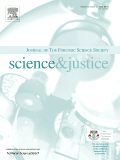
SCIENCE & JUSTICE
Exploring the Nexus of Science and Justice.Science & Justice is a leading international journal published by Elsevier Science Ltd, dedicated to the interdisciplinary examination of the intersection of justice and science, especially within the realms of forensic science and pathology. Established in 1995, this reputable journal has garnered a commendable Q2 rank in the category of Pathology and Forensic Medicine, reflecting its significant contributions to advancing knowledge in these critical fields. With an ISSN of 1355-0306 and an E-ISSN of 1876-4452, the journal is indexed in Scopus, positioning it in the top 68th percentile among its peers. The objectives of Science & Justice include promoting research that bridges scientific methodologies with justice-related applications, making it an invaluable resource for researchers, professionals, and students alike. As the journal continues to evolve, it aims to interface scientific innovations with forensic practices, thereby enhancing the integrity of justice processes globally. Despite not offering Open Access options, it remains a pivotal reference point within the academic community focused on forensic science methodologies and their legal implications.
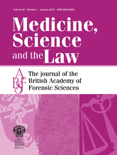
MEDICINE SCIENCE AND THE LAW
Exploring Ethical Frontiers in Medicine and LawMEDICINE SCIENCE AND THE LAW is a prestigious journal published by SAGE PUBLICATIONS INC, focused on the intersection of law, health policy, and ethical issues as they pertain to medicine. With a long-standing history dating back to 1960, this journal has become a crucial platform for scholars and professionals alike to share and disseminate research that shapes the evolving legal landscape surrounding health care practices. It holds notable positions in the academic community, ranking in the Q3 category for Health Policy and Issues, Ethics and Legal Aspects, and achieving a distinguished Q1 ranking in Law as of 2023. With rigorous peer-review standards and a commitment to publishing high-quality research, MEDICINE SCIENCE AND THE LAW is invaluable for those exploring the critical legal challenges and ethical dilemmas faced within the healthcare sector. Research contributions are vital for informing policy and practice, ensuring that the journal remains a relevant and essential resource for researchers, practitioners, and students dedicated to the intersection of law and medicine.
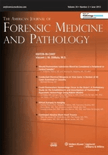
AMERICAN JOURNAL OF FORENSIC MEDICINE AND PATHOLOGY
Exploring the Intersection of Medicine and LawThe American Journal of Forensic Medicine and Pathology is a pivotal publication within the field of forensic science and pathology, dedicated to disseminating influential research and advancements in the evaluation of death and injury in legal contexts. Published by Lippincott Williams & Wilkins, this journal, which has been in circulation since 1980, serves as a vital resource for professionals, researchers, and students focused on intersecting disciplines such as medicine and forensic investigations. While it holds a respectable Q3 ranking in both the Medicine (Miscellaneous) and Pathology and Forensic Medicine categories as of 2023, the journal's impact is underscored by its contributions to the ongoing dialogue on forensic practices and methodologies. The American Journal of Forensic Medicine and Pathology provides a platform for innovative papers that shape the future of forensic science, also offering insights through case studies, reviews, and research articles that cater to its diverse readership. With an ISSN of 0195-7910 and E-ISSN 1533-404X, the journal continues to support the scholarly community in advancing knowledge within this critical field.
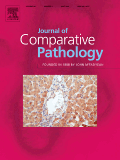
JOURNAL OF COMPARATIVE PATHOLOGY
Enhancing Diagnostic Accuracy Through Comparative StudiesJOURNAL OF COMPARATIVE PATHOLOGY, published by Elsevier Science Ltd, stands as a significant publication within the fields of pathology and forensic medicine, as well as veterinary studies. With an ISSN of 0021-9975 and an E-ISSN of 1532-3129, this journal has been disseminating critical research since 1950, contributing to the advancement of knowledge through its focus on comparative pathology. The journal's reputable standing is underscored by its Q3 classification in Pathology and Forensic Medicine and Q2 in Veterinary (miscellaneous) for 2023, reflecting its vital role in shaping contemporary discourse in these domains. The Scopus ranks further solidify its presence, placing it at the 51st percentile in general veterinary sciences and the 32nd percentile in pathology—a testament to the quality and relevance of the contributions it publishes. Although it operates under a subscription model, the journal remains accessible to researchers and practitioners who aim to deepen their understanding of pathological phenomena across species, enhance diagnostic accuracy, and improve clinical practices. With a steadfast commitment to rigorous peer review and a global readership, the JOURNAL OF COMPARATIVE PATHOLOGY is an essential resource for those engaged in research and professional practice, fostering collaborations and innovations that bridge complementary areas of study.

Revija za Kriminalistiko in Kriminologijo
Unveiling Innovations in Crime and Social PsychologyRevija za Kriminalistiko in Kriminologijo is a prominent academic journal dedicated to the fields of criminalistics, criminology, law, and forensic medicine, published by the Ministry of Interior Republic Slovenia. With its inception in 1981, the journal has served as a pivotal platform for disseminating research findings and innovative ideas relevant to crime and justice issues, particularly in the context of Slovenia and the wider region. Despite its current Q4 ranking in various categories, including Law and Pathology & Forensic Medicine, Revija za Kriminalistiko in Kriminologijo remains essential for emerging scholars and professionals seeking to contribute to the discourse in forensic science and social psychology. Although the journal does not offer open access options, it continues to publish rigorous peer-reviewed articles that significantly impact the field, making it a valuable resource for researchers, practitioners, and students alike. Scholars can access the research at the journal's address in Ljubljana, Slovenia, thereby fostering interdisciplinary collaboration and knowledge sharing.
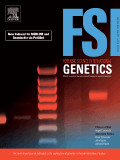
Forensic Science International-Genetics
Advancing Justice Through Genetic InsightForensic Science International-Genetics, published by Elsevier Ireland Ltd, stands as a pivotal resource in the realm of forensic science, particularly focusing on the intricate interplay of genetics within legal contexts. With an E-ISSN of 1878-0326, this esteemed journal serves to advance the understanding of genetic applications in forensic scenarios, enhancing methodologies and promoting innovations in evidence analysis. Recognized in the 2023 Q1 quartile rankings in both Genetics and Pathology and Forensic Medicine, it has established itself as a leading journal, positioned in the 87th percentile in the field of Pathology and Forensic Medicine. The journal spans valuable research from 2007 to 2025, making it a critical chronicle of evolving forensic practices. Researchers, professionals, and students alike will find an extensive compendium of peer-reviewed articles that not only address current challenges in forensic genetics but also foster collaboration and innovation across the scientific community. As a non-open access journal, it ensures high-quality content while offering insights essential for both academic study and practical application in forensic investigations.
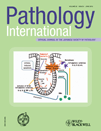
PATHOLOGY INTERNATIONAL
Elevating Research in Pathology and Forensic MedicinePATHOLOGY INTERNATIONAL, published by WILEY, stands as a distinguished journal in the field of pathology and forensic medicine, serving as an essential resource for researchers, clinicians, and students alike. With its ISSN 1320-5463 and E-ISSN 1440-1827, PATHOLOGY INTERNATIONAL has established itself since its inception in 1951, navigating through an evolving landscape in medical science with insights and breakthroughs up to 2024. It holds a commendable Q2 ranking in both the Medicine (miscellaneous) and Pathology and Forensic Medicine categories, indicating its robust influence and quality within these fields, as evidenced by its placement in the 70th percentile of Scopus rankings. While currently not an open-access journal, it provides access options that ensure valuable research remains available to the academic community. PATHOLOGY INTERNATIONAL commits to advancing the discipline through pioneering research articles, comprehensive reviews, and expert opinions that push the boundaries of understanding in pathology, thereby supporting the enhancement of diagnostic and therapeutic practices.
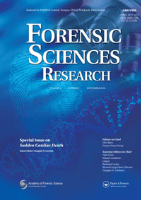
Forensic Sciences Research
Elevating Forensic Science with Cutting-Edge ResearchForensic Sciences Research is a distinguished open-access journal published by Oxford University Press, dedicated to the interdisciplinary field of forensic sciences. Since its inception in 2016, the journal has rapidly established itself as a vital resource for researchers, professionals, and students in areas including analytical chemistry, anthropology, biochemistry, genetic studies, and various branches of forensic medicine. With an impressive range of impact factor metrics across multiple categories—including Q1 rankings in Anthropology for 2023—this journal provides unparalleled access to high-quality research while facilitating the dissemination of innovative ideas and methodologies in forensic science. Researchers benefit from the journal's extensive Scopus ranking, which showcases its influential position within the academic community. The open-access model allows global accessibility, ensuring that vital forensic research reaches a diverse audience and contributes to advancements in public safety and legal processes. For those engaged in the practical realities of forensic investigation or the theoretical underpinnings of the field, Forensic Sciences Research is an indispensable journal that continues to advance knowledge and foster collaboration within the forensic community.

Forensic Toxicology
Bridging Disciplines for Enhanced Forensic InsightsForensic Toxicology is a premier journal published by Springer, renowned for delivering cutting-edge research in the realms of toxicology, biochemistry, and forensic medicine. With an ISSN of 1860-8965 and an E-ISSN of 1860-8973, this journal has established itself as a significant resource for professionals, researchers, and students engaged in the analysis of toxic substances within a forensic context. Its impressive impact factor and ranking reveal its influential presence in the field, particularly as it is categorized in Q1 for Pathology and Forensic Medicine and Q2 for Biochemistry (Medical) and Toxicology. Featured articles span a wide array of topics, facilitating interdisciplinary collaboration and advancing scientific knowledge. While currently not an open-access journal, it remains accessible through institutional subscriptions. With a convergence span from 2006 to 2024, Forensic Toxicology is committed to publishing high-quality research that enhances the understanding of toxicological phenomena and their implications in forensic investigations, reinforcing its role as an indispensable resource in the scientific community.

AJSP-Reviews and Reports
Unlocking Insights for Forensic InvestigationsAJSP-Reviews and Reports is a peer-reviewed journal dedicated to the advancement of knowledge within the field of pathology and forensic medicine. Published by the renowned Lippincott Williams & Wilkins, this journal plays a vital role in disseminating insightful reviews and reports that contribute to the understanding and application of diagnostic practices and forensic investigations. While currently listed in the fourth quartile (Q4) within its category according to the 2023 metrics, the journal is committed to enhancing its impact and fostering scholarly dialogue among researchers, professionals, and students in the medical community. Despite challenges in Scopus rankings, it provides a platform for significant discourse and innovation in pathology. Operating from the United Kingdom, AJSP-Reviews and Reports is positioned to bridge gaps in knowledge and inspire future research developments. Readers can access valuable findings without open access barriers, allowing for efficient information sharing within the medical field.